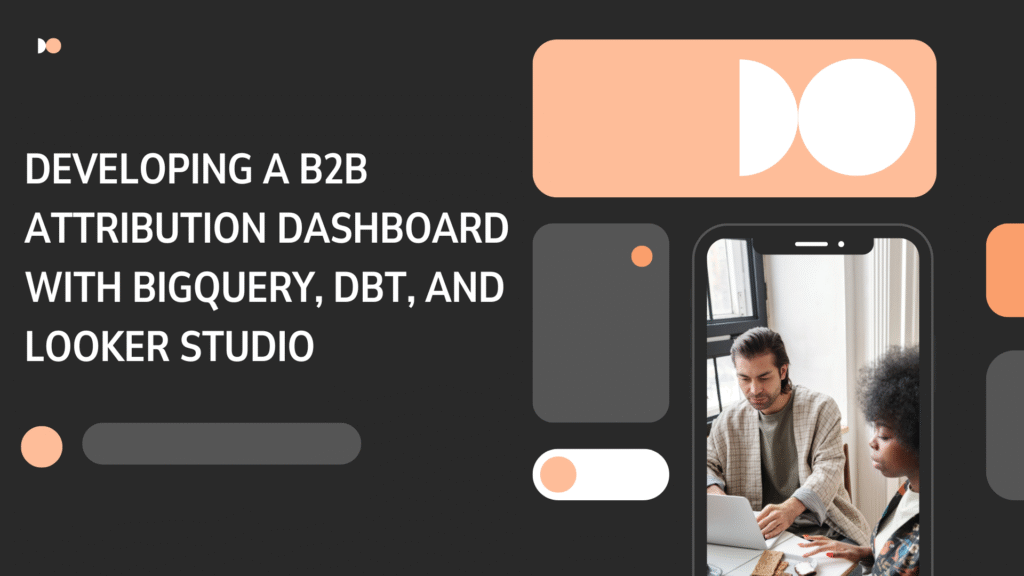
Introduction –
B2B marketing and sales teams are under growing pressure to demonstrate the impact of their campaigns and investments. Unlike B2C, where attribution is often more straightforward, B2B deals typically involve longer sales cycles, multiple stakeholders, and a variety of touchpoints before a contract is signed. Without a reliable way to connect marketing efforts to revenue, businesses struggle to make data-driven decisions about where to allocate budget and resources. This is where a B2B attribution dashboard becomes invaluable. By combining the power of BigQuery, dbt, and Looker Studio, organizations can build a scalable, automated, and highly visual solution for tracking attribution across the entire funnel.
The Need for B2B Attribution –
Attribution in B2B environments is notoriously complex. A potential customer may interact with an organization through multiple channels—such as webinars, whitepapers, LinkedIn ads, sales outreach, and in-person events—before moving through the pipeline. Traditional single-touch attribution models fail to capture this complexity, leading to an incomplete view of what truly drives revenue. A dedicated attribution dashboard helps unify these touchpoints, providing a more accurate picture of the buyer’s journey and enabling marketing and sales teams to collaborate more effectively.
Why Use BigQuery for Attribution Data –
BigQuery serves as the foundation for storing and processing attribution data. Its scalability allows organizations to handle large volumes of interaction and conversion data from multiple sources, including CRM systems, marketing automation platforms, and advertising channels. With BigQuery, teams can centralize their raw data in one place, ensuring consistency and reliability. Its SQL-based query engine makes it easy to aggregate and join datasets, allowing for faster insights across complex B2B buyer journeys.
Transforming Data with dbt –
While BigQuery provides the raw power for data storage and querying, dbt (data build tool) plays a critical role in transforming and modeling the data. Attribution analysis often requires complex logic, such as applying multi-touch attribution models or defining weighted credit across different touchpoints. dbt allows teams to manage these transformations as code, ensuring reproducibility, transparency, and version control. By modularizing the logic and building incremental models, dbt also helps maintain data quality while making the attribution layer easier to scale and maintain over time.
Visualizing Insights with Looker Studio –
Once the attribution data is prepared and modeled, Looker Studio (formerly Google Data Studio) provides the visualization layer. Looker Studio connects directly to BigQuery, enabling real-time dashboards without the need for additional data pipelines. Marketing and sales teams can explore interactive reports that show attribution by channel, campaign, content type, or account. The ability to apply filters, segment data, and drill down into touchpoints gives stakeholders the clarity they need to optimize their go-to-market strategies. Furthermore, Looker Studio’s sharing features make it easy to distribute dashboards across the organization, keeping everyone aligned on performance.
Key Benefits of This Stack –
Building a B2B attribution dashboard with BigQuery, dbt, and Looker Studio delivers multiple benefits. It creates a single source of truth for all attribution data, reducing discrepancies between departments. It provides scalability, as the stack can handle both small and enterprise-level datasets. It also introduces flexibility, since organizations can experiment with different attribution models—such as first-touch, last-touch, or multi-touch—without having to rebuild the pipeline. Most importantly, it empowers teams to make evidence-based decisions about marketing spend, sales alignment, and revenue growth.
Best Practices for Implementation –
When developing this type of dashboard, it is important to start with clear attribution goals. Defining whether the organization wants to measure pipeline influence, closed-won revenue, or account-level engagement helps guide the data modeling process. Ensuring data quality is another crucial step, as inaccurate or incomplete records can distort attribution results. Organizations should also consider governance, implementing proper access controls and documentation for transformations in dbt. Finally, involving both marketing and sales stakeholders throughout the design process ensures that the dashboard addresses the real needs of end users.
Conclusion –
Attribution in B2B environments is complex, but with the right data stack it becomes manageable and insightful. By leveraging BigQuery for data storage, dbt for transformation, and Looker Studio for visualization, organizations can build a powerful attribution dashboard that unifies data, enhances collaboration, and supports smarter decision-making. As competition intensifies in the B2B space, companies that invest in scalable attribution solutions will be better positioned to optimize their strategies, prove ROI, and drive sustainable growth.


